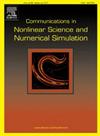Structure-preserving weighted BDF2 methods for anisotropic Cahn–Hilliard model: Uniform/variable-time-steps
IF 3.4
2区 数学
Q1 MATHEMATICS, APPLIED
Communications in Nonlinear Science and Numerical Simulation
Pub Date : 2024-10-16
DOI:10.1016/j.cnsns.2024.108395
引用次数: 0
Abstract
In this paper, we innovatively develop uniform/variable-time-step weighted and shifted BDF2 (WSBDF2) methods for the anisotropic Cahn–Hilliard (CH) model, combining the scalar auxiliary variable approach with two types of stabilized techniques. Using the concept of stability, the uniform-time-step WSBDF2 method is theoretically proved to be energy-stable. Due to the inapplicability of the relevant G-stability properties, another technique is adopted in this work to demonstrate the energy stability of the variable-time-step WSBDF2 method. In addition, the two numerical schemes are all mass-conservative. Finally, numerous numerical simulations are presented to demonstrate the stability and accuracy of these schemes.
各向异性 Cahn-Hilliard 模型的结构保持加权 BDF2 方法:均匀/可变时间步长
本文结合标量辅助变量方法和两种稳定技术,创新性地开发了各向异性卡恩-希利亚德(Cahn-Hilliard,CH)模型的均匀/变时步长加权和移位 BDF2(WSBDF2)方法。利用 G 稳定性概念,从理论上证明了均匀时间步长 WSBDF2 方法是能量稳定的。由于相关的 G 稳定性不适用,本研究采用了另一种技术来证明变时步长 WSBDF2 方法的能量稳定性。此外,两种数值方案都是质量守恒的。最后,大量的数值模拟证明了这些方案的稳定性和准确性。
本文章由计算机程序翻译,如有差异,请以英文原文为准。
求助全文
约1分钟内获得全文
求助全文
来源期刊

Communications in Nonlinear Science and Numerical Simulation
MATHEMATICS, APPLIED-MATHEMATICS, INTERDISCIPLINARY APPLICATIONS
CiteScore
6.80
自引率
7.70%
发文量
378
审稿时长
78 days
期刊介绍:
The journal publishes original research findings on experimental observation, mathematical modeling, theoretical analysis and numerical simulation, for more accurate description, better prediction or novel application, of nonlinear phenomena in science and engineering. It offers a venue for researchers to make rapid exchange of ideas and techniques in nonlinear science and complexity.
The submission of manuscripts with cross-disciplinary approaches in nonlinear science and complexity is particularly encouraged.
Topics of interest:
Nonlinear differential or delay equations, Lie group analysis and asymptotic methods, Discontinuous systems, Fractals, Fractional calculus and dynamics, Nonlinear effects in quantum mechanics, Nonlinear stochastic processes, Experimental nonlinear science, Time-series and signal analysis, Computational methods and simulations in nonlinear science and engineering, Control of dynamical systems, Synchronization, Lyapunov analysis, High-dimensional chaos and turbulence, Chaos in Hamiltonian systems, Integrable systems and solitons, Collective behavior in many-body systems, Biological physics and networks, Nonlinear mechanical systems, Complex systems and complexity.
No length limitation for contributions is set, but only concisely written manuscripts are published. Brief papers are published on the basis of Rapid Communications. Discussions of previously published papers are welcome.
 求助内容:
求助内容: 应助结果提醒方式:
应助结果提醒方式:


